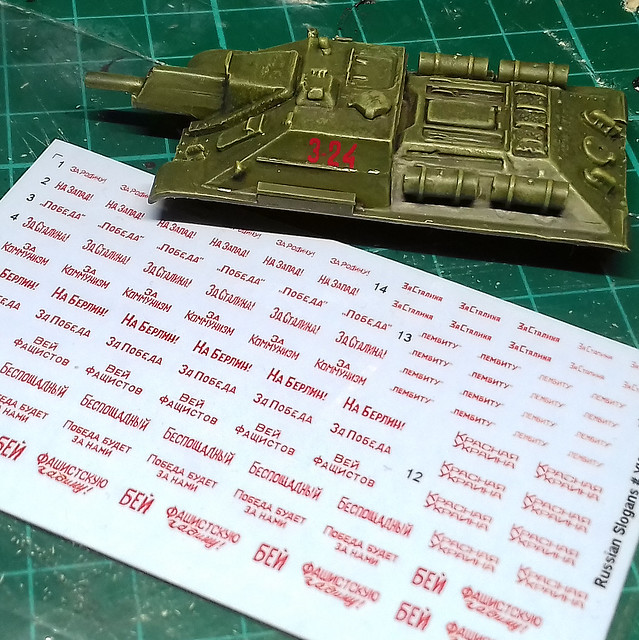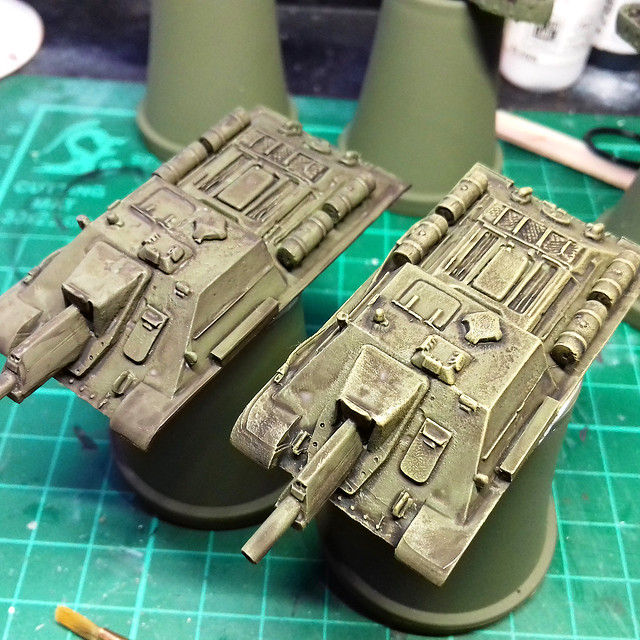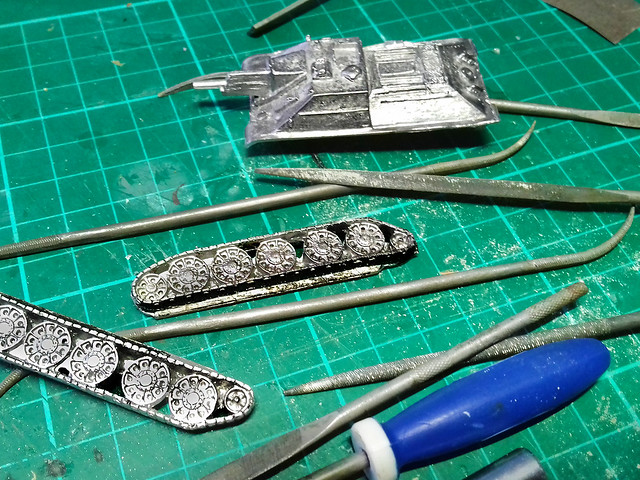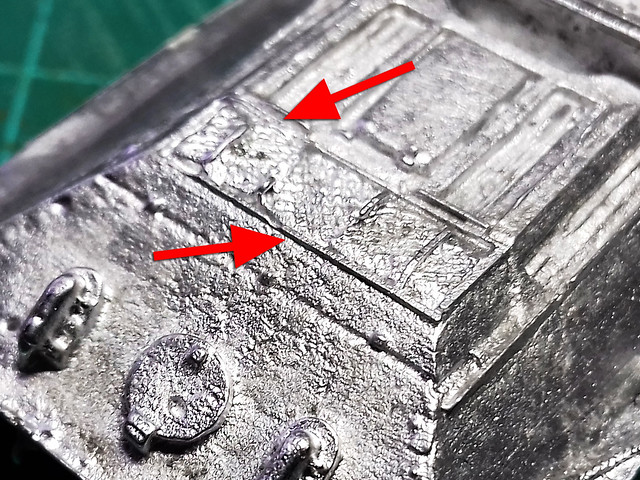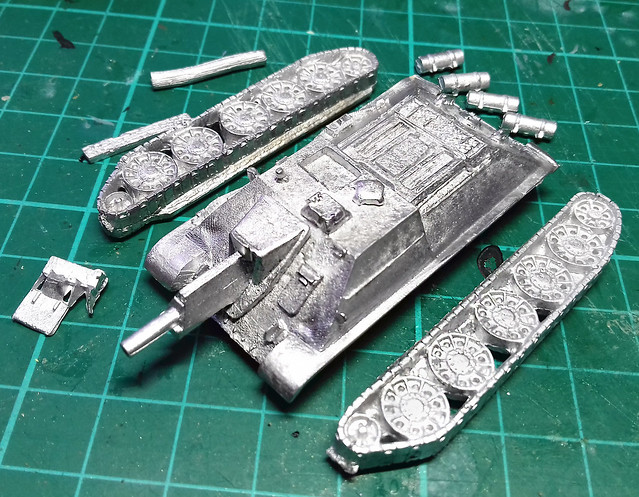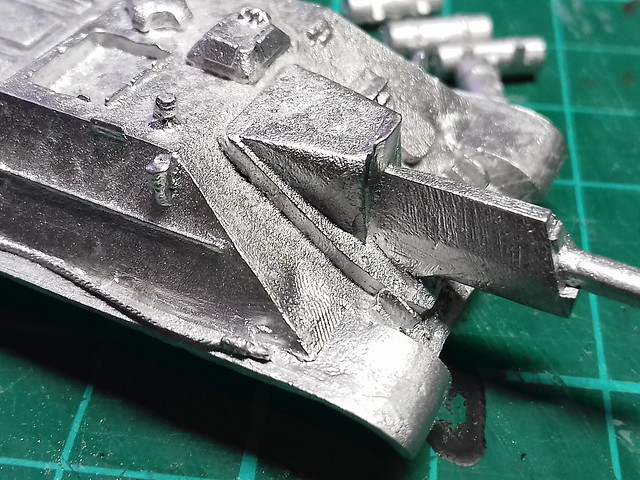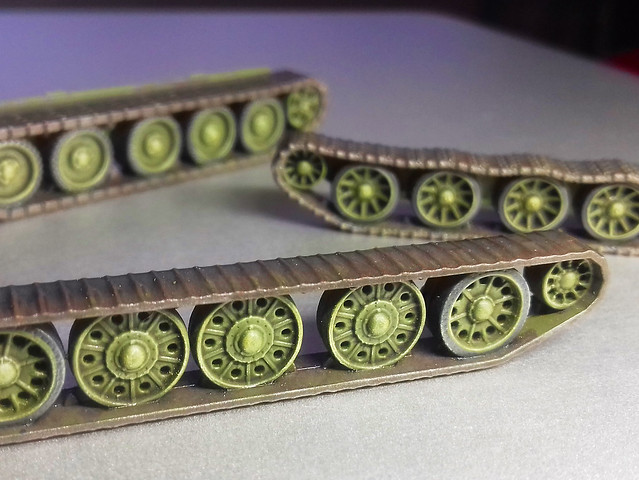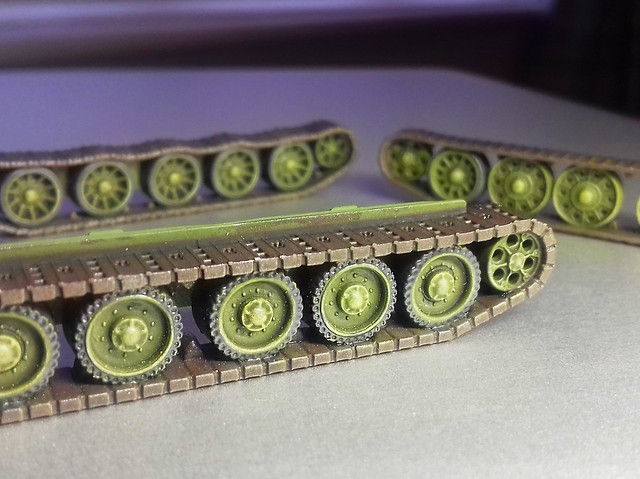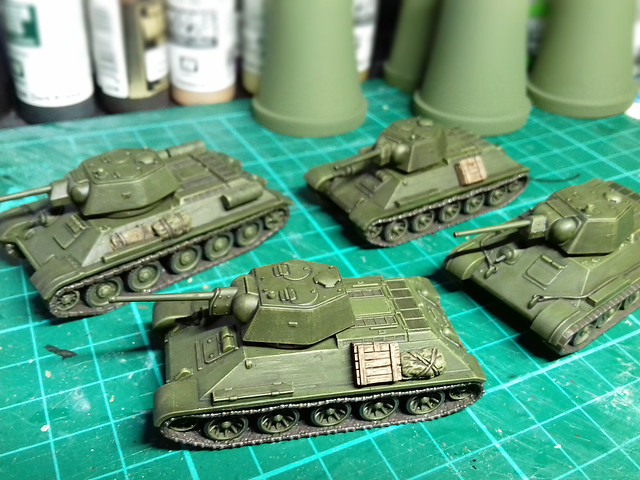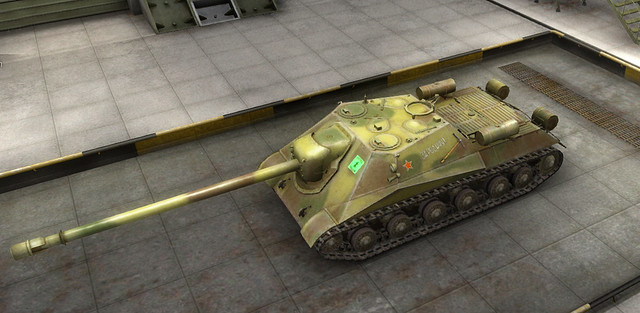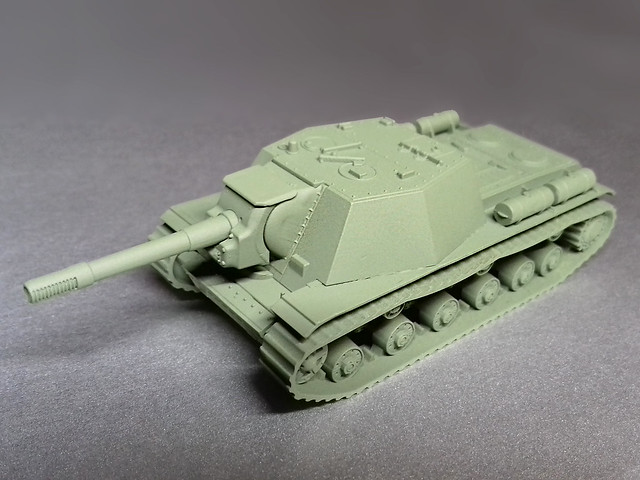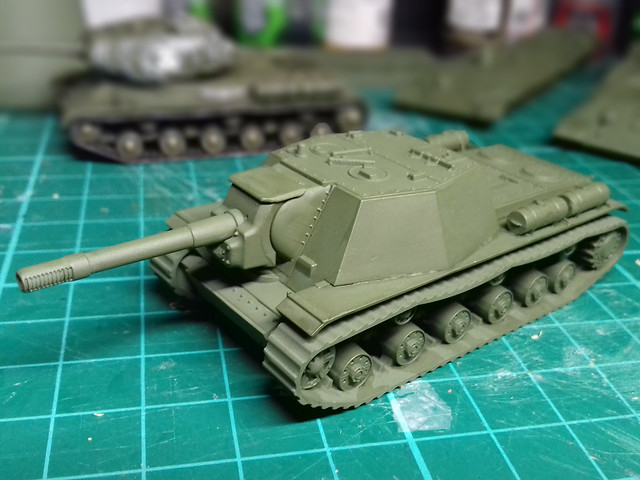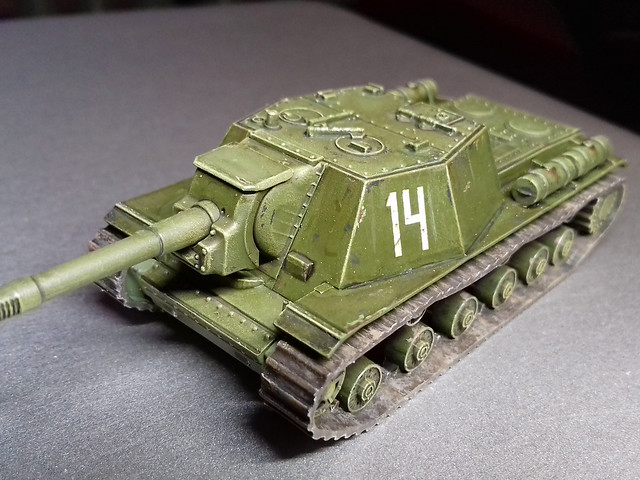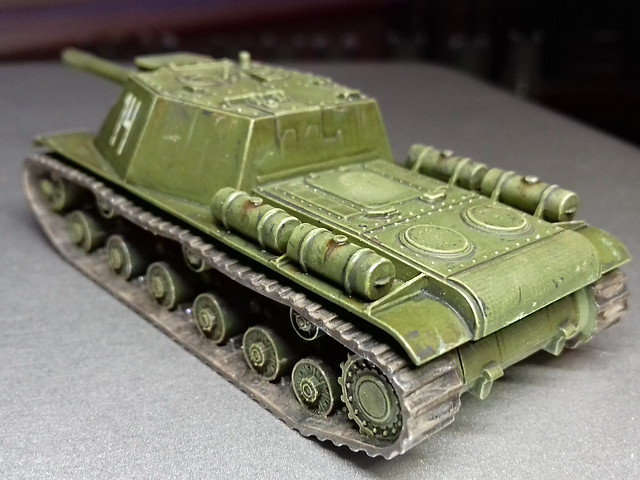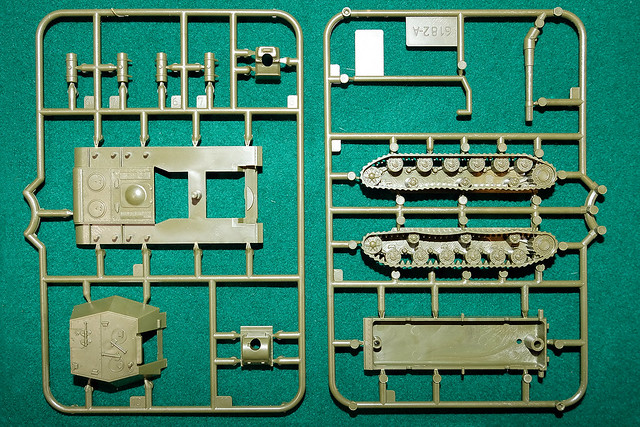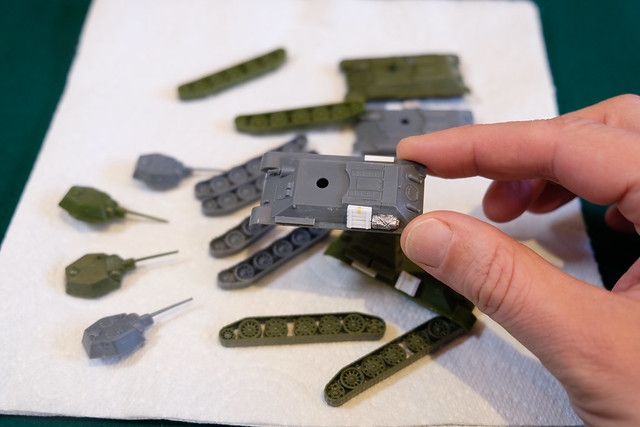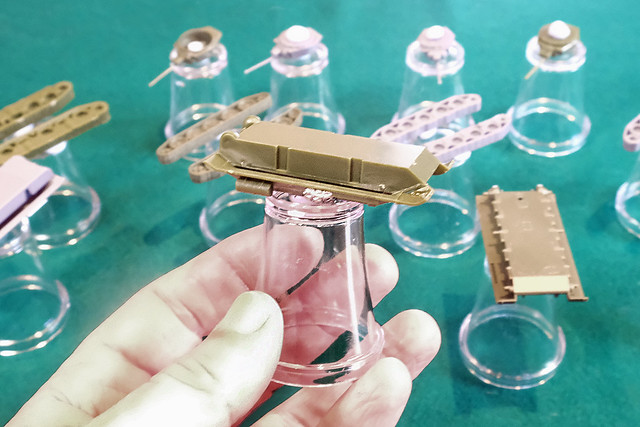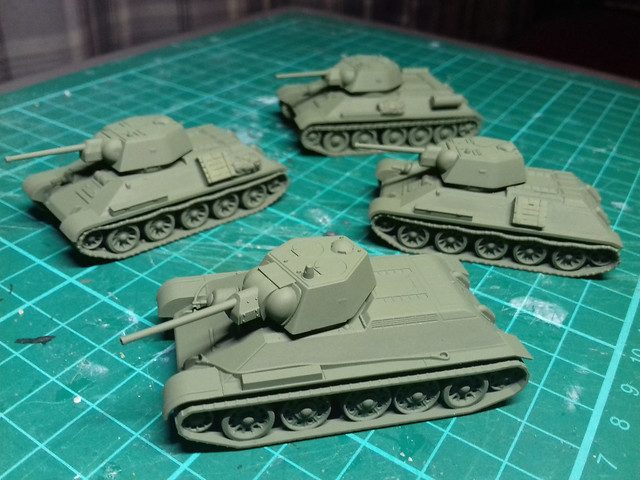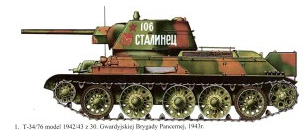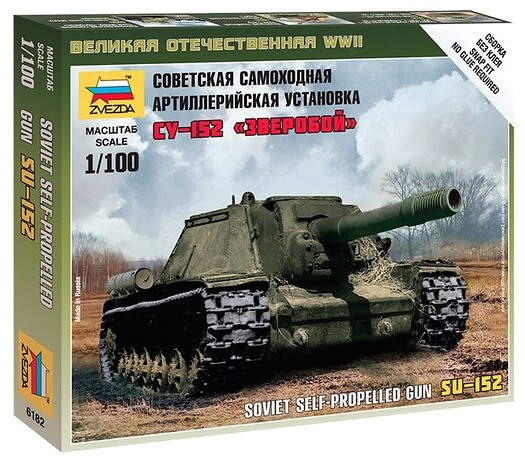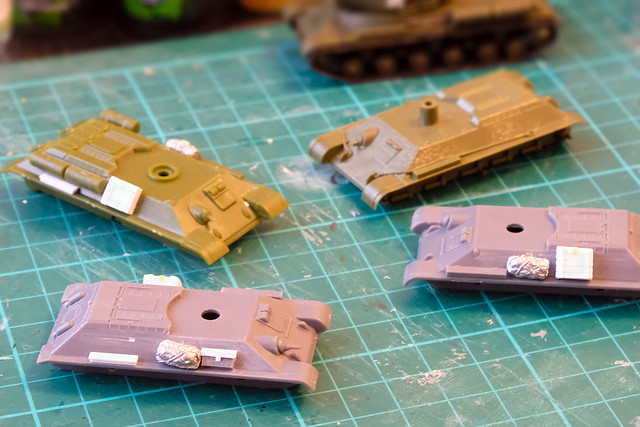My 1/100 WW2 Soviet tank force has been on hold while I awaited the arrival of some additional decals that I ordered. I'm glad to say that they have now popped through my letterbox!
These 1/144 Red Army slogans are the same as the white versions that I used on my 1/100 T-34s...But red (in both senses of the word)!
I'm trying to get both my T-34s and SU-122s to the same point in their painting so that I can do the next couple of stages in their weathering together, hence the wait.
I wasn't really satisfied with the red number decals that I had applied to this SU-122, I thought the tank looked a little mundane and needed a little something extra. So when I realised you could get the Red Army slogan decals in red I ordered them straight away (though, stupidly, I opted for second class postage which is why they took so long to come).
The decals are by 1/144 Direct in Glasgow. I just have to decide which slogan to add to my SU-122 (just below the numbers)...?
Next: Weathering my T-34s and SU-122s.
Diary of a novice scale model maker and his adventures in the wacky world of Braille Scale.
Wednesday 7 March 2018
Tuesday 27 February 2018
Skyrex 1/100 SU-122 - Part 3
Moving on from the priming, I've applied my now standard wash procedure for WW2 Soviet armour. A dark staining wash of Citadel Agrax Earthshade, followed by a light dry brushed highlighting of Vallejo Model Color Yellow Ochre.
It's a subtle process, but you might just be able to tell the difference if you study this photo. The unhighlighted SU-122 is on the left and the one with the yellow ochre dry brushing applied in on the right...
It just picks out the raised edges and corners and gives some small amount of 3-D tonal contrast on raised detail. At this stage it does look a little in your face (though I have seen some war-game modellers who like 'high contrast' stop at this point), so I prefer to take a step backwards - of sorts - and smooth out this contrasty highlighting with a overall modulating wash of diluted Vallejo Model Air Russian Green.
This - to me - ties together the underlying high contrast coats and flattens them out again with a rich semi-glaze (no it isn't actually a glaze, but the Russian Green is a rich colour that gives seem transparent jewel-like coating that tones down the contrasty undercoat). It's kinda hard to explain and - again - is subtle...But I am kinda liking the effect...
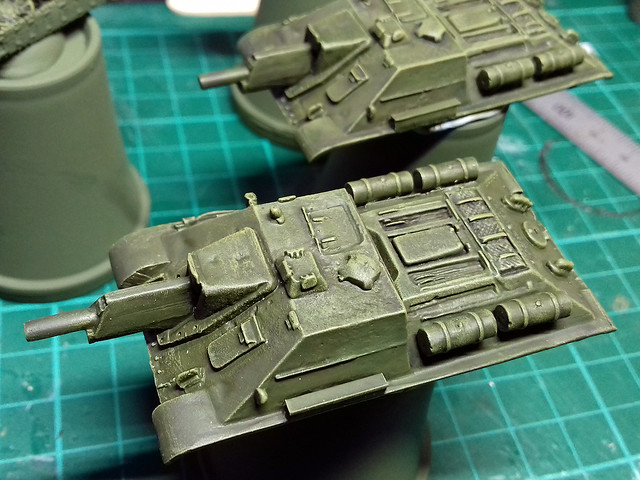 |
| The underlying contrast of the shadow wash and highlighting dry brushing is modulated by the overall wash of Russian Green. But, you still get the faint mottling of the darker shades showing through. |
Decals - We Don't Need No Sticking Badges!
Being a Soviet tanks less is more regarding markings. As far as I can see, the SU-122s in particular - being something of a stop-gap - was one of those Red Army vehicles that only got the most expedient of identifications...Principally a vehicle number.
 |
| Not exactly exciting markings but this seems to have been as complicated as it got for the SU-122s around the time of the Battle of Kursk. Source: Tanks-Encyclopedia.com |
I searched through my decal stash and found a couple of numbers that looked the right size (though they are not historically correct and are really meant for other Soviet vehicle types)...
Because these are just for wargaming and indicate examples of types I don't think we have to be too fastidious when it come to markings (they are not intended to be models of specific vehicles from specific units at a specific time). So long as they look the part I'm happy.
Next: Tracks and Mud
Monday 19 February 2018
Skyrex 1/100 SU-122 - Part 2
On with the prep work...This is the downside of white metal models and I find it a little tedious.
My main grumble about white-metal models is the inherent volatility of molten metal and it's propensity to distort and 'boil' (for want of a better word) during the moulding process. This effervescence of the molten metal during its transition into it's hardened state invariably results unpredictable flaws and blisters...And, sadly, such is the case with my SU-122.
I don't know why, but 'flash' always seems to form right at the most obvious point on a component, rather than at a point that is easily hidden or not seen...
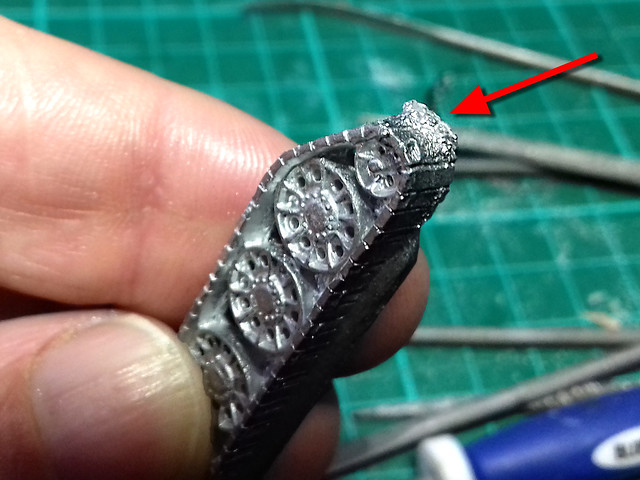 |
| This carbuncle of metal 'flash' had to form *right* on the front of the track! |
Simply removing the unsightly protuberances and neatening up may suffice for a war-game model...
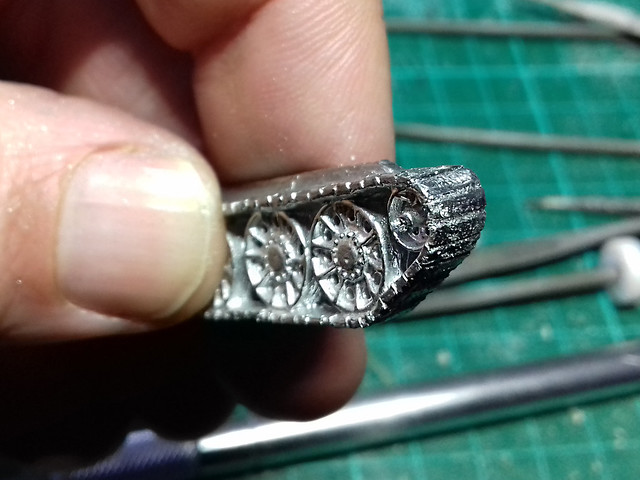 |
| Sadly, in filing down I have also lost some of the track pattern detail. :( |
It's the same on both models and is very disappointing. As I said, I don't want to try and rebuild flaws like this using Milliput or styrene strips and filling down in preparation to rebuild might actually do more harm than good. Perhaps a bit of judicious painting might help camouflage the broken detail.
On piece of work I did have to do, though, was on of the commander's hatches which I lost to the infamous Carpet Monster! However, it was a very simple job to cut a new rectangular hatch from a piece of styrene sheet and then to glue a couple of thin hinges on...
 |
| My replacement commander's hatch. |
Priming
Having got everything prepared (there was LOTS of labourious filing) I started to add the extras to the hull using superglue. I was a bit disappointed that the external fuel tanks had to be just glued directly to the surface of the hull - without any guide pins or holes - and the side mounted tool boxes did not fit at all (I had to make my own out of plastic). Also, it turned out that the metal unhitching logs were a bit oversized and looked a little odd so I ended up leaving them off completey.
You do have the option to leave off the fuel tanks (reference photos show the SU-122 with and without them) and if you do that there is enough space for adding an unhitching log. But I would still recommend that you make your own log out of thinner diameter plastic rod.
All that done, I primed with Humbrol's Light Olive acrylic spray, just as I have with the rest of my Soviet armour for this project...
Well, they don't look quite as bad as I had imagined that they might when I looked at these model in the raw metal. Hopefully, as I apply more painting effects they will look even better!
I do have to keep reminding myself as these models are intended to be seen at tabletop distance (say, at least two feet away - don't ask me what that is in centimeters). So, we shall see.
Next: Operation 'Disguise the shoddy detail with paint' begins!
Sunday 11 February 2018
Skyrex 1/100 SU-122 - Part 1
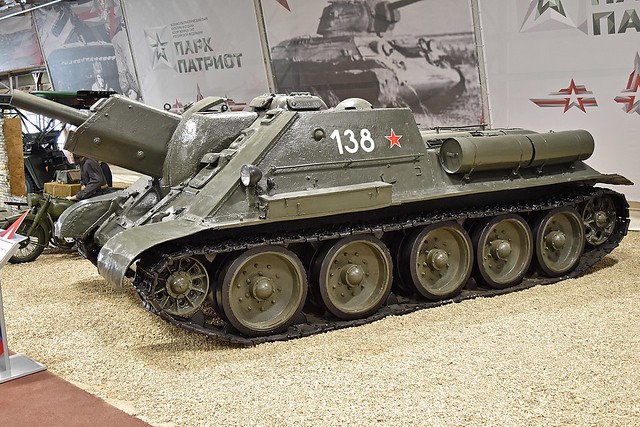 |
| SU-122 in Kubinka Tank Museum. Source: Wikipedia. |
The SU-122 was the Red Army's answer to the highly successful German Stug III assault gun/tank destroyer. This design of fixed gun housing on a medium tank chassis suited the Soviet's need for large numbers of quick to build and cheap fighting vehicles. The chief advantage of this design was that you could shoe-horn a larger gun into the housing than you could get in the equivalent vehicle with a rotating turret, thus - while normal T-34 designs were mounting a 76mm main gun - this gun carriage could mount a hefty 122mm howitzer!
The Skyrex Model Overview
While I would have preferred to have stuck with plastic models for my 'Battle of Kursk' project, sadly none of the main 1/100 plastic kit manufacturers make a SU-122 (and I didn't fancy taking on a T-34 conversion project). So, as I only required two of these models, I dug deep and splashed out on a pair of Skyrex metal models (£6.50 each plus postage).
There are only four main parts (main hull, 2 x tracks and commander's hatch) plus four external fuel tanks, a tool box and a 'unditching log'. [Apologies for the lack of clarity of the photos, but bare metal is quite difficult to photograph.]
As usual, for a white-metal model, there is a little flash and a tiny bit of deformity so 'cleaning up' mainly involves smoothing out any pitting, bits of flash and scratches with some mild filing and shaving. Additionally, I've been told that it's good practise to give all surfaces a quick rub down with some 'wet and dry' paper to remove any of the moulding medium residue.
Detail wise, it's a mixed bag, but this is the compromise you make when having to resort to a low run metal moulding compared to a high volume plastic injection kit. The crispness of detail you get with plastic just isn't there, but - again - there isn't a plastic SU-122 model in this scale...So, be content! ;)
Because of the lack of definition with some of the detail (particularly the engine deck) I'm a bit worried about how the painting will pan out.
😬 <--- My worried face!
Well, I better get my file and 'wet and dry' out and get going...
Next: Priming, where I should get a better idea about how some of that detail might turn out.
Saturday 10 February 2018
1/100 Plastic T-34/76 Kits - Part 5
It's taking some getting used to working on several similar models at one and the same time. I'm really not sure how people manage to do whole 'regiments' of vehicles for large scale games like Flames of War, I'm finding the repetition tiring with just a troop of four T-34s!
Anyway, gripe aside, all the track sets (4 sets, so 8 parts) went fairly well...
The dry-brushed highlighting is somewhat exaggerated for effect (nearly yellow, in fact). But, I'm beginning to get into this whole war-gaming style of painting, though I guess it might be very easy to get carried away.
In this case, however, I shall be toning the high contrast down a bit when I add an additional shading wash. Once that is done and I have pin-washed the shadow areas in the wheels I'll start to think about how much - if any - mud and weathering to apply to the tracks.
Now, onto the hull(s)...
First job is to paint the base colours of all the stowage and gear. I tried out Vallejo's Model Color Cork Brown for the wooden storage crates, it gives a nice light wood tone. The tarpaulins are various shades of khaki-green and metal equipment is metallic-grey (silver mixed with panzer grey)...
I won't bore you by repeating photos that I've shown before as my 1/100 process is starting to become pretty well 'set', so I'll just bullet-point the stages after priming and detail base painting:
• MODULATION WASH: A quick wash of Vallejo Model Air Russian Green (once I get my airbrush up and going again I will simply prime any Soviet vehicles with Vallejo's Russian Green Primer, thus eliminating a stage).
• HIGHLIGHTING: I've begun to highlight in two stages. First a general light dry brushing of a Russian Green/Ochre-Yellow mix to give some high-contrast highlights to raised detail and to give some lightening shade to the upper surfaces angels (tops of surfaces). This is followed by a more focused highlighting (near white) on the very most prominent edges and detail (I used a mix of Vallejo White and German Yellow [806] for this extreme highlighting).
• SHADOW SHADING/ PIN-WASHING: Application of Citadel's Agrax Earthshade (over-all wash) and Nuln Oil (focused pin-wash) shading tints to panel lines and any areas I want to deepen in tone.
• FINISHING WASH: This is something new I'm trying out. To *unify* all the previous wash effects I finish off with a wash of Citadel's Athenian Camoshade. Let me explain; using multiple layers of washes one onto of another - particularly dark washes - can get a little messy. You can end up with patches and streaks, and so - to smooth out and counter these unwanted blemishes - I apply an overall wash of Citadels darker green shade. It pulls everything together and adds a rich sheen to the Russian Green.
Lastly, some of these processes are repeated for effect. For example, I gently highlighted again after the shadow wash/finishing wash or, if a shadow in a panel is not deep enough, I might add an additional shadow wash to that specific area.
I know...This all sounds like a lot of work. But going down the route of multi-layer washes to build up effects seems to create a complicated tonal end product that suits me more than trying to subtly airbrush shading effects at this small scale. If you are more comfortable with airbrushing instead...Go for it! It's all down to personal taste. :)
Ready for Weathering
And here we are, all ready to start the weathering and advanced detailing/effects stage of painting...
Next: Weathering & Completion
Anyway, gripe aside, all the track sets (4 sets, so 8 parts) went fairly well...
The dry-brushed highlighting is somewhat exaggerated for effect (nearly yellow, in fact). But, I'm beginning to get into this whole war-gaming style of painting, though I guess it might be very easy to get carried away.
In this case, however, I shall be toning the high contrast down a bit when I add an additional shading wash. Once that is done and I have pin-washed the shadow areas in the wheels I'll start to think about how much - if any - mud and weathering to apply to the tracks.
Now, onto the hull(s)...
First job is to paint the base colours of all the stowage and gear. I tried out Vallejo's Model Color Cork Brown for the wooden storage crates, it gives a nice light wood tone. The tarpaulins are various shades of khaki-green and metal equipment is metallic-grey (silver mixed with panzer grey)...
I won't bore you by repeating photos that I've shown before as my 1/100 process is starting to become pretty well 'set', so I'll just bullet-point the stages after priming and detail base painting:
• MODULATION WASH: A quick wash of Vallejo Model Air Russian Green (once I get my airbrush up and going again I will simply prime any Soviet vehicles with Vallejo's Russian Green Primer, thus eliminating a stage).
• HIGHLIGHTING: I've begun to highlight in two stages. First a general light dry brushing of a Russian Green/Ochre-Yellow mix to give some high-contrast highlights to raised detail and to give some lightening shade to the upper surfaces angels (tops of surfaces). This is followed by a more focused highlighting (near white) on the very most prominent edges and detail (I used a mix of Vallejo White and German Yellow [806] for this extreme highlighting).
• SHADOW SHADING/ PIN-WASHING: Application of Citadel's Agrax Earthshade (over-all wash) and Nuln Oil (focused pin-wash) shading tints to panel lines and any areas I want to deepen in tone.
• FINISHING WASH: This is something new I'm trying out. To *unify* all the previous wash effects I finish off with a wash of Citadel's Athenian Camoshade. Let me explain; using multiple layers of washes one onto of another - particularly dark washes - can get a little messy. You can end up with patches and streaks, and so - to smooth out and counter these unwanted blemishes - I apply an overall wash of Citadels darker green shade. It pulls everything together and adds a rich sheen to the Russian Green.
Lastly, some of these processes are repeated for effect. For example, I gently highlighted again after the shadow wash/finishing wash or, if a shadow in a panel is not deep enough, I might add an additional shadow wash to that specific area.
I know...This all sounds like a lot of work. But going down the route of multi-layer washes to build up effects seems to create a complicated tonal end product that suits me more than trying to subtly airbrush shading effects at this small scale. If you are more comfortable with airbrushing instead...Go for it! It's all down to personal taste. :)
Ready for Weathering
And here we are, all ready to start the weathering and advanced detailing/effects stage of painting...
Next: Weathering & Completion
Thursday 8 February 2018
Featured Work - Carsten's 'Object 704'
It's been a while since I posted a 'featured work' and I think that's possibly because I've been working in 1/100 scale recently. There are some terrific examples of beautifully painted 1/100 scale armour around if you Google them, but not so many tutorial examples (at least, not as many as - say - 1/72 scale tutorials anyway).
So, it was great to come across this wonderful example of what can be done at this diminutive scale. Particularly so as the modeller - Carsten - uses a lot of techniques and medium that are more usually associated with larger scales...
Another delightful aspect of this video is that Carsten's subject if the 'Object 704', which is a late WW2 prototype Soviet tank destroyer. I'm quite familiar with this monster as it's a tank which is available in the PC game 'World of Tanks'. Indeed, it's one of my favourite tanks to play in this game...
Computer games aside, though, this is a very useful tutorial on with some very interesting pointers about advanced painting techniques for 1/100 armour. I'll undoubtedly be trying out some of these tips in the various tanks I'm just producing.
So, it was great to come across this wonderful example of what can be done at this diminutive scale. Particularly so as the modeller - Carsten - uses a lot of techniques and medium that are more usually associated with larger scales...
Computer games aside, though, this is a very useful tutorial on with some very interesting pointers about advanced painting techniques for 1/100 armour. I'll undoubtedly be trying out some of these tips in the various tanks I'm just producing.
Wednesday 7 February 2018
Zvezda 1/100 SU-152 'Animal Killer' - Part 2
Well, this project isn't going to take long!
...So, moving along briskly, it's on with the painting. And, because I've a pretty well defined painting plan for these Soviet tanks 'briskly' is the operatively word...
[Note: I took the pictures as I went along with my mobile phone - for convenience sake - so, unfortunately, the colour reproduction varied wildly, depending on the lighting. My apologies.]
1. Priming - Humbrol Light Olive Green
2. Modulation - Vallejo 'Russian Green' Wash
3. Painting Tracks - Basics
First stage in my track painting (for these 1/100s) is to base coat the tracks with a mix of 70/30 Vallejo Model Color 'German C. Black Brown' [822] and Game Color 'Plata Silver' [052]. This just gives the tracks a vaguely rusty-metallic lustre...
Next I brush on a dark brown wash of Citadel Agrax Earthshade (slightly diluted). But, be careful, as this wash doesn't seem to like too much water added and will sometimes dry with a white residue. I've been told that to avoid this you should dampen the surface you are applying the wash to first.
Anyway, the wash gives nice definition to detail and gives the base colour a slightly dirty look...
On top of this I dry-brush a highlighting colour of Vallejo's Model Color Yellow Ochre [913] (mixed with a little Vallejo Model Air Russian Green for effect). This is just to make the most prominent detail 'pop' out a bit.
And finally (prior to weathering anyway), I do some pin-washing using Citadel's Nuln Oil shade [wash]. This is to deepen some of the most shaded detail in the road wheels...
4. Highlighting (Dry Brushing) the Hull
These stages repeat the wash, highlighting and pin-wash processes described above. This stage is very subtle so I've skipped photographic it. BUT, it is worth doing as once the next stage of shading wash has been applied it gives some very subdued highlighting to raised edges and panel lines.
(As these are war-game models I've started experimenting with some high-contrast highlighting by using a little white. It's not very realistic per say but it is a nice effect. I highlight with my yellow/green mix, then dry-brush a little whiter mix on top - just on the very most prominent features.)
5. Shadow Shading - Citadel Agrax Earthshade
6. Pin Wash - Citadel Nuln Oil
With the pin-washing done, this brings the hull and the tracks to the same stage of basic painting.
7. Decals
I'm not basing this tank on any specific historical vehicle, so the decals are just to add character to the model. I begin by a flicking through my collection of spare decals and found a set of - appropriately - large Cyrillic numbers ('14') that I thought would compliment such a big tank.
The model was prepped with a light patch of Humbrol's 'Gloss Cote' on the hull where the decal would be placed. As usual, Microscope's Micro Set was used to help seat and set the decal in place...
Sometimes less is more with Red Army armour!
(Another light coat of Humbrol varnish would be applied on top of the decal to seal the transfer permanently.)
8. Chipping, Grime & Weathering
As this is a war-game model there will be plenty of character about it, and this includes a slightly exaggerated amount of weathering. This is definitely 'just for fun' and not strictly historical.
I'll start with chipping as, it seems to me that, grime and dust would naturally occur on top of chips and scratches (maybe). I use Vallejo's Panzer Aces Dark Rubber [306] and dot and dab it in minute patches and scratches on areas I think would see wear and tear...
Aside from the grey ('flakey paint') chips I'll additionally add the occasional speck of silver to simulate chips that have gone down to bare steel (like chips on hinges and wheel rims, etc). I could add some touches of graphite pencil to get that metallic look to the surface (I shall try this out on the bottom of the hull first to see if I like it.)
And finally, I'll add a few grime, stain and oil streaks to the hull and slightly discolour the decals to get rid of that 'new' looking brightness.
9. Finishing Tracks - Weathering
As above, there will be a touch of chipping and silver flecks to imply scratches (I also did a little silver dry-brushing to give a metallic sheen to the steel tracks). But the main job will be to add dust and dirt (or mud if I want a very weathered look). This is the bit I always dread as it's so easy to get carried away. So, before the mud...
(Edit: I thought the tracks looked a bit flat - in tone - so I added a wash of Vallejo's Game Color Wash in Sepia Shade [200]. This added a nice tinge of rust to the bare steel of the track links.
And, after the mud...
10. Finishing Up...
Well, I just can't resist tinkering and I did some more chipping and streaking. But that's normal with me - I just can't leave well enough alone!
I'm fairly pleased with this model, though a little disappointed with how the tracks turned out. It's perhaps half to do with how simplified the tracks were - offering scant detail - and half my poor 'mud' painting technique (I shall have to practise with some other medium).
But, let's not get too negative...This is a perfectly fine war-game piece for GF9 Tanks, and that's the main thing.
All that's left if to varnish the model. I'll probably go with several light coats as it's intended to be handled. Other than that, it's on with the next models in this project - my T-34s.
...So, moving along briskly, it's on with the painting. And, because I've a pretty well defined painting plan for these Soviet tanks 'briskly' is the operatively word...
[Note: I took the pictures as I went along with my mobile phone - for convenience sake - so, unfortunately, the colour reproduction varied wildly, depending on the lighting. My apologies.]
1. Priming - Humbrol Light Olive Green
2. Modulation - Vallejo 'Russian Green' Wash
3. Painting Tracks - Basics
First stage in my track painting (for these 1/100s) is to base coat the tracks with a mix of 70/30 Vallejo Model Color 'German C. Black Brown' [822] and Game Color 'Plata Silver' [052]. This just gives the tracks a vaguely rusty-metallic lustre...
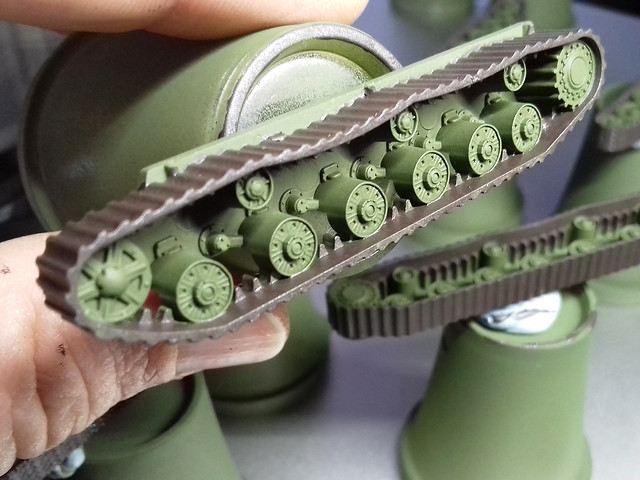 |
| This shot shows the very basic nature of the track detail (or rather, the lack of track detail)! |
Anyway, the wash gives nice definition to detail and gives the base colour a slightly dirty look...
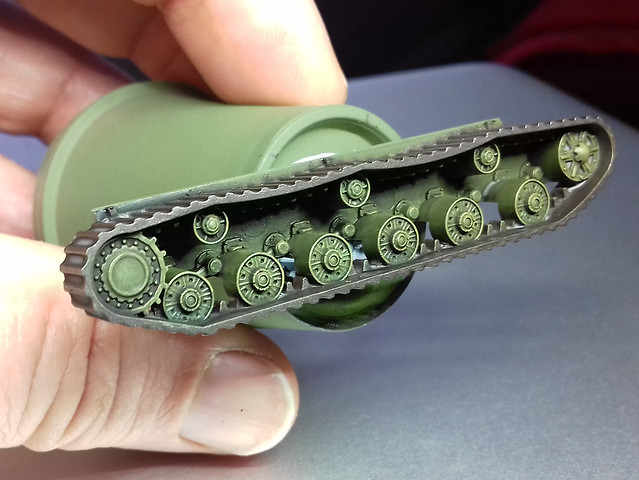 |
| Compare this to the picture above. Notice how the wash has picked out the details of the road wheels in particular. |
And finally (prior to weathering anyway), I do some pin-washing using Citadel's Nuln Oil shade [wash]. This is to deepen some of the most shaded detail in the road wheels...
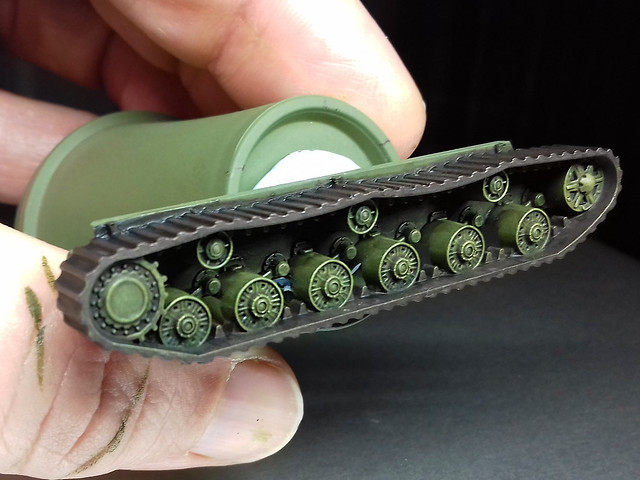 |
| Yes, subtle I know, but believe me, some of the deeper detail is now better defined and shaded. I may re-highlight a it, but otherwise onwards we go! |
These stages repeat the wash, highlighting and pin-wash processes described above. This stage is very subtle so I've skipped photographic it. BUT, it is worth doing as once the next stage of shading wash has been applied it gives some very subdued highlighting to raised edges and panel lines.
(As these are war-game models I've started experimenting with some high-contrast highlighting by using a little white. It's not very realistic per say but it is a nice effect. I highlight with my yellow/green mix, then dry-brush a little whiter mix on top - just on the very most prominent features.)
5. Shadow Shading - Citadel Agrax Earthshade
6. Pin Wash - Citadel Nuln Oil
With the pin-washing done, this brings the hull and the tracks to the same stage of basic painting.
7. Decals
I'm not basing this tank on any specific historical vehicle, so the decals are just to add character to the model. I begin by a flicking through my collection of spare decals and found a set of - appropriately - large Cyrillic numbers ('14') that I thought would compliment such a big tank.
The model was prepped with a light patch of Humbrol's 'Gloss Cote' on the hull where the decal would be placed. As usual, Microscope's Micro Set was used to help seat and set the decal in place...
Sometimes less is more with Red Army armour!
(Another light coat of Humbrol varnish would be applied on top of the decal to seal the transfer permanently.)
8. Chipping, Grime & Weathering
As this is a war-game model there will be plenty of character about it, and this includes a slightly exaggerated amount of weathering. This is definitely 'just for fun' and not strictly historical.
I'll start with chipping as, it seems to me that, grime and dust would naturally occur on top of chips and scratches (maybe). I use Vallejo's Panzer Aces Dark Rubber [306] and dot and dab it in minute patches and scratches on areas I think would see wear and tear...
 |
| It's debatable whether - at this scale - small detail effects like chipping are needed. I shall decide when I see the finished model. |
And finally, I'll add a few grime, stain and oil streaks to the hull and slightly discolour the decals to get rid of that 'new' looking brightness.
9. Finishing Tracks - Weathering
As above, there will be a touch of chipping and silver flecks to imply scratches (I also did a little silver dry-brushing to give a metallic sheen to the steel tracks). But the main job will be to add dust and dirt (or mud if I want a very weathered look). This is the bit I always dread as it's so easy to get carried away. So, before the mud...
(Edit: I thought the tracks looked a bit flat - in tone - so I added a wash of Vallejo's Game Color Wash in Sepia Shade [200]. This added a nice tinge of rust to the bare steel of the track links.
And, after the mud...
 |
| I'm not happy with my 'mud' technique yet. I keep trying out new medium, in this case it's Tamiya's Weathering Sticks. I think I prefer powders. |
Well, I just can't resist tinkering and I did some more chipping and streaking. But that's normal with me - I just can't leave well enough alone!
I'm fairly pleased with this model, though a little disappointed with how the tracks turned out. It's perhaps half to do with how simplified the tracks were - offering scant detail - and half my poor 'mud' painting technique (I shall have to practise with some other medium).
But, let's not get too negative...This is a perfectly fine war-game piece for GF9 Tanks, and that's the main thing.
All that's left if to varnish the model. I'll probably go with several light coats as it's intended to be handled. Other than that, it's on with the next models in this project - my T-34s.
Sunday 4 February 2018
1/100 Plastic T-34/76 Kits - Part 4
One Track Mind...
Er, make that 10 track mind! The downside of production line model making for war-game is; yes, you get a nice little army of models at the end, BUT this means that every stage in building and painting becomes a intimidating and repetitive chore...
I'll be discussing my exact paint process for these 1/100 scale tanks and their tracks in my next post (about my SU-152), but here's a quick overview in bullet-point form:
• Prime tracks (mine are all over light olive)...
• Paint tracks base colour - I've chosen a metallic dark-brown...
• Apply dark wash (Citadel Agrax Earthshade) all over...
• Dry-brush highlight green on road wheels...
• Highlight track tread with metallic colour or graphite pencil...
• Pin-wash road wheels and track treads with black (Citadel Nuln Oil)...
• Apply dust of mud effects (to your tastes)...
• Seal with varnish.
Next: Painting the hull and turret.
Er, make that 10 track mind! The downside of production line model making for war-game is; yes, you get a nice little army of models at the end, BUT this means that every stage in building and painting becomes a intimidating and repetitive chore...
 |
| Tracks all-over primed and track links painted base colour. |
• Prime tracks (mine are all over light olive)...
• Paint tracks base colour - I've chosen a metallic dark-brown...
• Apply dark wash (Citadel Agrax Earthshade) all over...
• Dry-brush highlight green on road wheels...
• Highlight track tread with metallic colour or graphite pencil...
• Pin-wash road wheels and track treads with black (Citadel Nuln Oil)...
• Apply dust of mud effects (to your tastes)...
• Seal with varnish.
Next: Painting the hull and turret.
Friday 2 February 2018
Zvezda 1/100 SU-152 'Animal Killer' - Part 1
My 'Battle of Kursk' project trundles forward apace with this monstrous addition to my Soviet force. The 152mm gunned SU-152, known as the 'Animal Killer' (or 'Beast Killer') as it was designed specifically to hunt the German's Tigers, Panthers and Elephants.
Quick Overview
I've made no secret that I love Zvezda's little 1/100 range of armour. Their level of accuracy for a simple 'easy build' war-game model is excellent (bar one detail) and the cost is very attractive compared to the competition.
However, every silver lining has a grey cloud attached and Zvezda kits have two slight drawbacks; they don't tend to come with optional builds/accessories and their tracks are...Well...'Bare bones'.
The Zvezda SU-152 follows this format, the kit has only 12 parts with no 'optionals' and the tracks are a little disappointing. BUT, these kits are what they are and as war-game markers they are more than adequate.
Unfortunately, to keep the part count down something had to give and that was the complexity (or lack thereof) of the tracks. Making the track sub-assembly one-piece - including wheels, suspension and the tracks themselves - seems to have impacted just how much detail can be included on the moulding. I guess they figured that - at 1/100 scale and being partially hidden by the fenders - the track pattern would not be a overtly noticeable feature. This is a matter of opinion.
(As mentioned in my 1/100 T-34/76 post, the best tracks are those done by Plastic Soldier Company. But they achieved their nice track components by using three-piece assemblies.)
However, the rest of the detail is well represented for the scale and is crisp and delicately moulded. (Other 1/100 armour manufacturers tend to go for a slightly exaggerated 'chunky' look so that details show up better - and are more easily painted.)
The massive 152mm gun barrel is not 'drilled out', but that's easily remedied. I drilled a tiny pilot hole first - to ensure the hole was centred properly - before drilling out the final barrel width with a larger drill.
Options?
Although the kit does not come with options, it might be nice to add some stowage. Things like tool boxes or a piece of timber for 'unditching', which was a common practise on Soviet tanks. I could scratch build these easily.
Next: Painting.
 |
| An abandoned SU-152 assault gun inspected by German troops, Russia, 1943. (These Germans must be counting their blessings!) Source: Wikipedia |
I've made no secret that I love Zvezda's little 1/100 range of armour. Their level of accuracy for a simple 'easy build' war-game model is excellent (bar one detail) and the cost is very attractive compared to the competition.
However, every silver lining has a grey cloud attached and Zvezda kits have two slight drawbacks; they don't tend to come with optional builds/accessories and their tracks are...Well...'Bare bones'.
The Zvezda SU-152 follows this format, the kit has only 12 parts with no 'optionals' and the tracks are a little disappointing. BUT, these kits are what they are and as war-game markers they are more than adequate.
Unfortunately, to keep the part count down something had to give and that was the complexity (or lack thereof) of the tracks. Making the track sub-assembly one-piece - including wheels, suspension and the tracks themselves - seems to have impacted just how much detail can be included on the moulding. I guess they figured that - at 1/100 scale and being partially hidden by the fenders - the track pattern would not be a overtly noticeable feature. This is a matter of opinion.
(As mentioned in my 1/100 T-34/76 post, the best tracks are those done by Plastic Soldier Company. But they achieved their nice track components by using three-piece assemblies.)
However, the rest of the detail is well represented for the scale and is crisp and delicately moulded. (Other 1/100 armour manufacturers tend to go for a slightly exaggerated 'chunky' look so that details show up better - and are more easily painted.)
 |
| Completed in just a few minutes, at tabletop distance it's a lovely looking model. |
Options?
Although the kit does not come with options, it might be nice to add some stowage. Things like tool boxes or a piece of timber for 'unditching', which was a common practise on Soviet tanks. I could scratch build these easily.
Next: Painting.
Thursday 1 February 2018
1/100 Plastic T-34/76 Kits - Part 3
Cleaning, Priming & Base Colour Planning
A process I - and other modellers - do, and yet I have never mentioned it on this blog, is to wash the 'raw' plastic sub-assemblies before priming! I don't know why I have never mentioned this before as it is quite an important stage in the painting process.
It's also a very simple process (maybe that's why I have overlooked it before), but novice modellers tend to either not know about this process or chose to ignore it.
To be fair, I didn't clean my raw models before priming when I started, but when I did eventually try it I immediately understood why people do this. For example, I tend to file and sand my models a lot - either to remove sprue nubs or moulding seams or to correct details - and this causes microscopic particles of plastic dust to cling to the surface of your kit.
For some reason, you only seem to notice these small grains of plastic once you have primed, and then it's too late. Sometimes the tiny blemishes can be scraped off and the primer can be retouched, but there is nothing more annoying than discovering particles of dust spoiling you nice neat primer coat!
So, I bath my sub-assemblies in warm, soapy water. This gets rid of most particles and any surface grease left behind by your fingers (this can be just your natural skin oils, but can form a barrier to the primer paint).
Priming
Before spraying I mounted all of the sub-assemblies onto little plastic shot glasses that I got from a local thrift store. I like to mount parts for spraying and painting as I like a 'handle' to hold onto the part. It makes it easier to manipulate for painting details.
I have used cheap corks before, but I prefer these shot glasses as they can put down and stand on their own, which is great for when paint is drying. I stick the parts to the glasses using BluTac...
And from there it was onto the spray booth turntable. As usual, I'll be breaking out the Humbrol [86] Light Green Olive Acrylic Spray as a light base for my 'Russian Green' wash...
As much as I am enamoured by this particular make of rattle can, I'm starting to question the economics of aerosols as primers, more especially when you have several identical models to spray. I'm considering moving across to airbrush primers once I have gotten back to using an airbrush again.
But, in the meantime, I am still impressed with the nice smooth coat that the Humbrol spray gives me...
Planning the Colour Scheme
Being mid-war Soviet tanks you could get away with a very simple colour scheme, Russian Green. But I'd like to do something a little different, just to give some visual variety (I know some people like uniformity when it comes to war-game tank squadrons), so I looked around to find examples of those rare occasions that the Red Army used camouflage schemes.
While the Soviets made great use of winter schemes, summer multi-coloured camo patterns are relatively rare as far as I can see. But I found one example that looks interesting...
I've seen this two-tone green and tan/brown scheme a couple of times and quite like it. I'll probably just do one of my T-34s in this, just to imply that different regiments are involved in my game. Just for fun! :)
As for the other three, variously weathered plain green, I think.
Next: Painting.
A process I - and other modellers - do, and yet I have never mentioned it on this blog, is to wash the 'raw' plastic sub-assemblies before priming! I don't know why I have never mentioned this before as it is quite an important stage in the painting process.
It's also a very simple process (maybe that's why I have overlooked it before), but novice modellers tend to either not know about this process or chose to ignore it.
To be fair, I didn't clean my raw models before priming when I started, but when I did eventually try it I immediately understood why people do this. For example, I tend to file and sand my models a lot - either to remove sprue nubs or moulding seams or to correct details - and this causes microscopic particles of plastic dust to cling to the surface of your kit.
For some reason, you only seem to notice these small grains of plastic once you have primed, and then it's too late. Sometimes the tiny blemishes can be scraped off and the primer can be retouched, but there is nothing more annoying than discovering particles of dust spoiling you nice neat primer coat!
So, I bath my sub-assemblies in warm, soapy water. This gets rid of most particles and any surface grease left behind by your fingers (this can be just your natural skin oils, but can form a barrier to the primer paint).
Priming
Before spraying I mounted all of the sub-assemblies onto little plastic shot glasses that I got from a local thrift store. I like to mount parts for spraying and painting as I like a 'handle' to hold onto the part. It makes it easier to manipulate for painting details.
I have used cheap corks before, but I prefer these shot glasses as they can put down and stand on their own, which is great for when paint is drying. I stick the parts to the glasses using BluTac...
And from there it was onto the spray booth turntable. As usual, I'll be breaking out the Humbrol [86] Light Green Olive Acrylic Spray as a light base for my 'Russian Green' wash...
As much as I am enamoured by this particular make of rattle can, I'm starting to question the economics of aerosols as primers, more especially when you have several identical models to spray. I'm considering moving across to airbrush primers once I have gotten back to using an airbrush again.
But, in the meantime, I am still impressed with the nice smooth coat that the Humbrol spray gives me...
Planning the Colour Scheme
Being mid-war Soviet tanks you could get away with a very simple colour scheme, Russian Green. But I'd like to do something a little different, just to give some visual variety (I know some people like uniformity when it comes to war-game tank squadrons), so I looked around to find examples of those rare occasions that the Red Army used camouflage schemes.
While the Soviets made great use of winter schemes, summer multi-coloured camo patterns are relatively rare as far as I can see. But I found one example that looks interesting...
I've seen this two-tone green and tan/brown scheme a couple of times and quite like it. I'll probably just do one of my T-34s in this, just to imply that different regiments are involved in my game. Just for fun! :)
As for the other three, variously weathered plain green, I think.
Next: Painting.
Wednesday 31 January 2018
The 'Cat Killers' Are Here!
New to my stash for my 'Battle of Kursk' themed wargame are three lovely 1/100 Soviet tank destroyers. The plastic Zvezda SU-152 and two Skyrex white metal SU-122s...
Although I call them 'Cat Killers' I believe the nickname really translates from Russian as 'Animal Killers' - referring to their intended victims, the German Tigers, Panthers and Elephants - and it really was only applied to the SU-152 and it's massive gun. Still, the SU-122's big gun was nothing to be sniffed at either and had the same function - to get rid of those pesky Kraut Heavies!
These will make up the core of my Soviet force for my planned game of GF9 'TANKS!', as the Soviets fought more defensively in this battle.
Although I call them 'Cat Killers' I believe the nickname really translates from Russian as 'Animal Killers' - referring to their intended victims, the German Tigers, Panthers and Elephants - and it really was only applied to the SU-152 and it's massive gun. Still, the SU-122's big gun was nothing to be sniffed at either and had the same function - to get rid of those pesky Kraut Heavies!
These will make up the core of my Soviet force for my planned game of GF9 'TANKS!', as the Soviets fought more defensively in this battle.
Sunday 28 January 2018
1/100 Plastic T-34/76 Kits - Part 2
A *very* slow Sunday on the workbench, due to having to babysit the daughter's very needy dog! ("No, don't make models, tickle me...Me, me, me!")
Anyway, got the stowage done for my T-34s - just a few extra tool boxes and what-not. I also trimmed off the horrible plastic 'bumps' that are supposed to represent the 'hand rails', so I'm a lot more satisfied now.
It seems to me that making accessories for 1/100 scale armour is a little anal, but I can't seem to kick the habit. But you can tell I'm more used to making such things in 1/72 scale as my attempts are a little on the big side. Still, they add variety onto otherwise very spartan Soviet tanks.
And that's it for today, I'm afraid. Not a big modelling weekend really and the time has flown.
Next: I'll clean the models with soapy water before applying the primer coat.
Anyway, got the stowage done for my T-34s - just a few extra tool boxes and what-not. I also trimmed off the horrible plastic 'bumps' that are supposed to represent the 'hand rails', so I'm a lot more satisfied now.
It seems to me that making accessories for 1/100 scale armour is a little anal, but I can't seem to kick the habit. But you can tell I'm more used to making such things in 1/72 scale as my attempts are a little on the big side. Still, they add variety onto otherwise very spartan Soviet tanks.
And that's it for today, I'm afraid. Not a big modelling weekend really and the time has flown.
Next: I'll clean the models with soapy water before applying the primer coat.
Subscribe to:
Posts (Atom)
